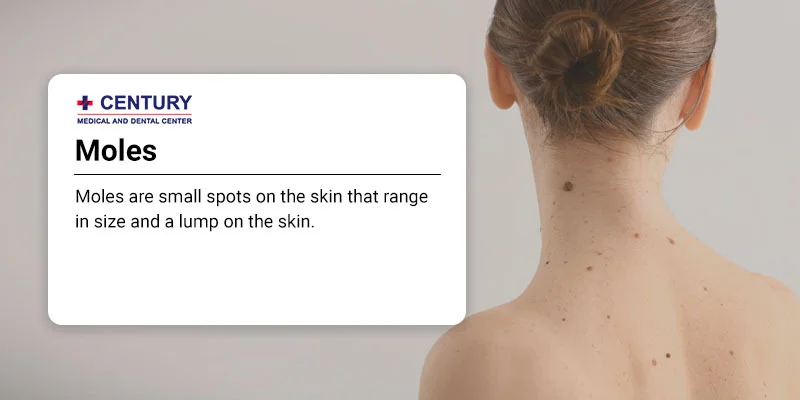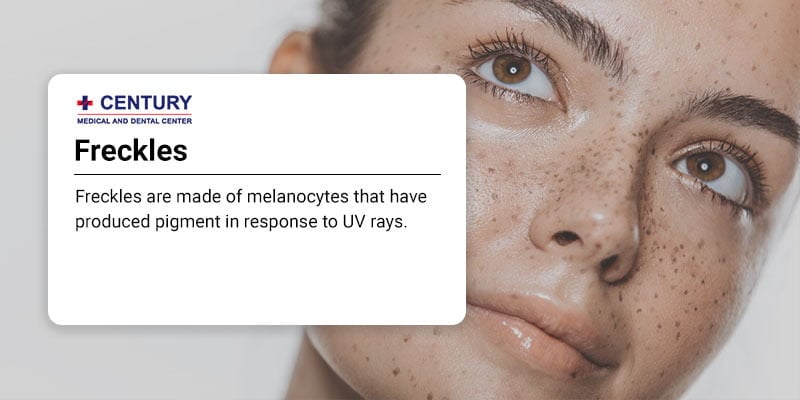Moles and freckles are regular skin features that most people have as a result of genetics or exposure to the sun. Knowing the difference between moles and freckles will help you understand them better and know when to be concerned about them. Consult an experienced dermatologist at the Century Medical and Dental Center if you have moles or freckles and want to know more about what causes them and what to do if they change their color or form. The expert skin doctors examine your moles and freckles carefully and screen them using advanced equipment to keep a close eye on your skin changes.
Moles and freckles are skin lesions or structural changes that are very common and mostly benign. They can be recognized with their characteristic appearance, the way they appear or change their form.
Moles and freckles add a distinctive and unique appearance. Both are dark spots on the skin caused by extra-pigmented skin cells that are a common occurrence, but the similarity ends here. Knowing this difference can help you determine if it is a mole or a freckle that you are seeing.
Here is all the information you will need to differentiate between them.
Moles are small spots on the skin that range in size and a lump on the skin. Moles usually develop when skin cells grow in clumps or clusters on top of each other instead of spreading throughout the skin. They can be flat or have a wrinkly top and vary in color. Sometimes hair may also grow out of moles.
They can be brown, tan, black, red, blue, or even pink in color due to the melanocytes, the pigment that gives skin its natural color. Moles originate deeper in skin layers. They mostly appear at a young age and stay till our later years. They may darken after exposure to the sun, during their teen years, or during pregnancy.

Freckles are made of melanocytes that have produced pigment in response to UV rays. Melanin is a pigment, or color, that helps protect skin from exposure to the sun by reflecting or absorbing harmful ultraviolet rays. Freckles tend to be lighter in color than moles, but they can be dark too, almost black. Freckles are found in the superficial layers of skin cells.
Freckles are often genetic, although they are caused by excessive exposure to the sun. They can suddenly appear, but they are more noticeable in winter when the skin is pale, and they stand out. They may also fade and disappear over time.

Even though they appear to be the same, moles and freckles are different. The best way to tell the difference between a mole and a freckle is to feel the area. Moles are raised from the skin surface while freckles are flat.
It is the exposure to the sun rays that cause melanocytes to create more melanin and develop a darker spot on the skin. Melanocytes are distributed throughout your skin, and the melanin they produce is the natural pigment that gives your skin its color.
Difference between a freckle and a mole
Moles look like a type of growth on the skin, and they are as frequent as freckles. Moles can appear as small, dark brown spots, which result when melanocytes grow in clusters and clumps. Moles are darker than freckles and deeper in the skin.
People with fair or light complexions have less melanin in their skin. When the sunlight causes their melanocytes to make more, they often get freckles instead of an equal tan.
Moles are round or oval. Due to their complex composition, they can be smooth or wrinkled and flat or bumpy depending on the development of the cells that cause them. Most moles are smaller than a pencil eraser, less than 1/4 inch or about 6 millimeters in diameter.
Freckles appear as flat, beige, or brown circular spots that usually are the size of the head of a metal nail. These spots are multiple and may develop on sun-exposed skin after repeated exposure to sunlight. These are particularly common in people with red hair and a fair complexion.
Most moles are not dangerous or cancerous. Moles that have the potential of malignant transformation will change. They will either grow or show a different border. Symptoms like itching or bleeding are also concerning, and you must pay attention to other pigmented patches and see a doctor immediately if there is any change.
Freckles and moles have two things in common. There is a genetic tendency to get them, and both are darker than the surrounding skin. But there is one big difference, freckles do not turn malignant.
You should watch out for:
If you notice a mole getting darker or growing, or find a spot on the skin as an adult, visit a doctor to be on the safe side and have your skin checked. Moles that do not show any signs of being cancerous are left untouched.
The chances of moles becoming cancerous are very slim, but being aware of what can happen will help you keep an eye on your condition. A cancerous mole is removed with a portion of the surrounding skin to ensure long-term wellness.
Knowing about moles and beauty marks is essential as it helps determine if you need any medical assistance. In most cases, a mole and beauty mark are the same thing, but the placement of moles can often add to a person’s appearance, and for this reason, they have been called beauty marks.
Moles located on the face, neck, shoulder, and collarbone areas are considered beauty marks. While they are attractive, they are still moles and must be checked if they begin to shape their shape, size, or color.
Freckles vary in color depending on the individual and genetic makeup. Excessive exposure to the sun can also cause the freckles to darken.
They are not harmful, but they should not be taken lightly, as they are a sign that your skin has been exposed for a long time to the sun. Not only this, but the dark spots can also make you look older. If your freckles begin to darken to the point they disturb you, it is best to consult a doctor. There are options to lighten or have them removed.
Moles and freckles are not a health hazard but monitoring their appearance is necessary for understanding the difference between them and taking care of yourself. Schedule a visit with the top-rated dermatologist at the Century Medical and Dental Center to get your skin tested and learn more about protecting your skin from harmful toxins and environmental attacks. The skin specialist will address your concerns and guide you on taking care of your skin to help you stay healthy and look good.
Century Medical and Dental Center is an accredited healthcare facility in NY that operates in accordance with Article 28, a public health law. This law regulates and recognizes accreditation for public healthcare facilities, ensuring they are licensed and operated correctly. By undergoing the Article 28 process and achieving accreditation, Century Medical and Dental Center demonstrates its commitment to meeting the highest standards of care.
As a multidisciplinary medical center, we have highly qualified doctors, nurses, and support staff who are working hard to provide the best medical care to patients in Manhattan, NY, Brooklyn, NY, and Bronx, NY including Brooklyn Heights, Dumbo, Prospect Heights, Park Slope, Clinton Hill, Boerum Hill, Red Hook, Harlem, Gravesneck, Flatbush, and Bedford-Stuyvesant.